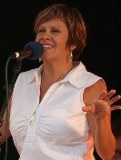

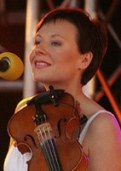
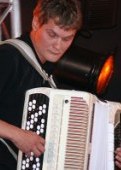
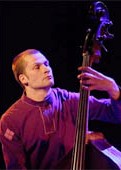
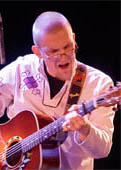
FolkWorld Issue 41 03/2010; Article by Eelco Schilder






|
Warm, Uplifting and Sparkling
Burlakat: Ancient Music from Karelia
With their latest album Oma, the Finnish band Burlakat proves to be one of the finest representatives of the Karelian musical culture. Since their first appearance in 1994, they are loved for their warm, uplifting and sparkling interpretation of ancient Karelian songs and dances. Lead singer and Kantele player Johanna Koukkunen tells about the past and present of the band and tries to explain the uniqueness of this ancient culture.
Johanna has been surrounded by music ever since her early childhood. Especially singing was one of the great pleasures of her youth. Was it only singing?
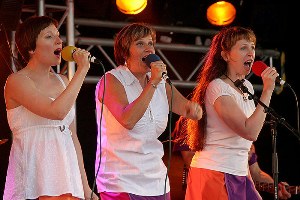 |
‘My mother and father were born in that part of Karelia, which Russia took away from Finland after the war. So as small children they had to move away from their homes. My father's first language was the Karelian language. He and my mother were travelling a lot around Finland in the 1970's performing Karelian folksongs and sometimes I performed with them. I think that explains why many Karelian folksongs are so familiar to me.’
‘Besides singing folk songs, I sung in a church choir as well. I come from an orthodox family; my grandfather was an orthodox priest. So as you can see, music has always been one of the most important things in my life. In 1993 I choose to study the small Kantele and besides attending folk music courses, I started study folk singing.’
It was on one of the folk music courses where she met some of the early Burlakat musicians and started playing Finnish traditional songs. Most of the musicians, who were part of the group at this early stage, have left the band by now. Although violinist and singer Pauliina Lerche is still part of the today’s line up. How were those early days?
‘We started playing Finnish folksongs but soon I introduced the Karelian music. In fact, we even played Balkan melodies at that time. These early years a lot of changes took place in the group and together with Pauliina, I’m the only one left. The first record in 1999 is quite different from the others and I think that on our second album Magie we recorded music that people would recognize as the Burlakat sound as we have today.’
Karelian music slowly became the main ingredient of the band’s repertoire. What is so specific for this culture, what makes it unique?
‘I find it very difficult to explain this the right way in English. Singing has always played a main role in Karelian tradition. Poems were put to music, stories weren’t only told, but sung as well. In fact the stories of Kalevala are mostly origin from Karelia. The themes of the songs are universal. About the Karelian nature and about the relationships between boys and girls. Both sorrows and joys were sung. If you read the translations you might get a good picture of the themes. One singing style should really be mentioned and that is the ‘Crying’. This is like singing and crying at the same time and was used, for example, in weddings and funerals. I find it very difficult to explain what this style really is and we don’t sing in this style, it was a speciality of old women to do this in Karelia.’
‘The kantele is one of the instruments that are often used in Karelian music, same as the Jouhikko, another string instrument. Because of its geographical position the music includes influences from Russian, Finland and the Baltic states.’
When material is found, how do you turn it into a Burlakat piece?
‘It happens, that I search for some traditional Karelian song or songs and we start developing it during practise. Or someone else finds a good melody and we search for words that fit to the melody. Then we make the arrangements together. Many of us have also composed some songs for Burlakat. In the newest record there are three songs from Jukka and one song from me. Some of the songs have been arranged by only one of us. So there are many different types of processing the music. The thing that binds us is the joy we have by making music together. We have lot of skills and we are full of energy on stage. We have developed our own unique style to make music and especially Karelian music.’
It took a while after the second album to come with this third one ‘oma’. How was the process towards this album and why did this take such a long time?
‘ It was time to start with a new record, because it was quite a lot of time from the “Magie” CD. We had new songs and there were some new players in the group. We also got money from a fund, so it was possible to start a new record. The process took a long time. Lasse (the band’s accordionist) and I lived two years in Spain, so it was quite difficult to practise and get timetables for recording together. We started in autumn 2007 and the record was released in July 2009. But we do feel that we got a good result. On this new CD we focussed even more on Karelian tradition, than on earlier CD’s and we hope that it helps us a bit closer to our dream; playing our music in different places all around the world’
Photo Credits:
(1)-(7) Burlakat (from website).
|
To the German FolkWorld |
© The Mollis - Editors of FolkWorld; Published 03/2010
All material published in FolkWorld is © The Author via FolkWorld. Storage for private use is allowed and welcome. Reviews and extracts of up to 200 words may be freely quoted and reproduced, if source and author are acknowledged. For any other reproduction please ask the Editors for permission. Although any external links from FolkWorld are chosen with greatest care, FolkWorld and its editors do not take any responsibility for the content of the linked external websites.
